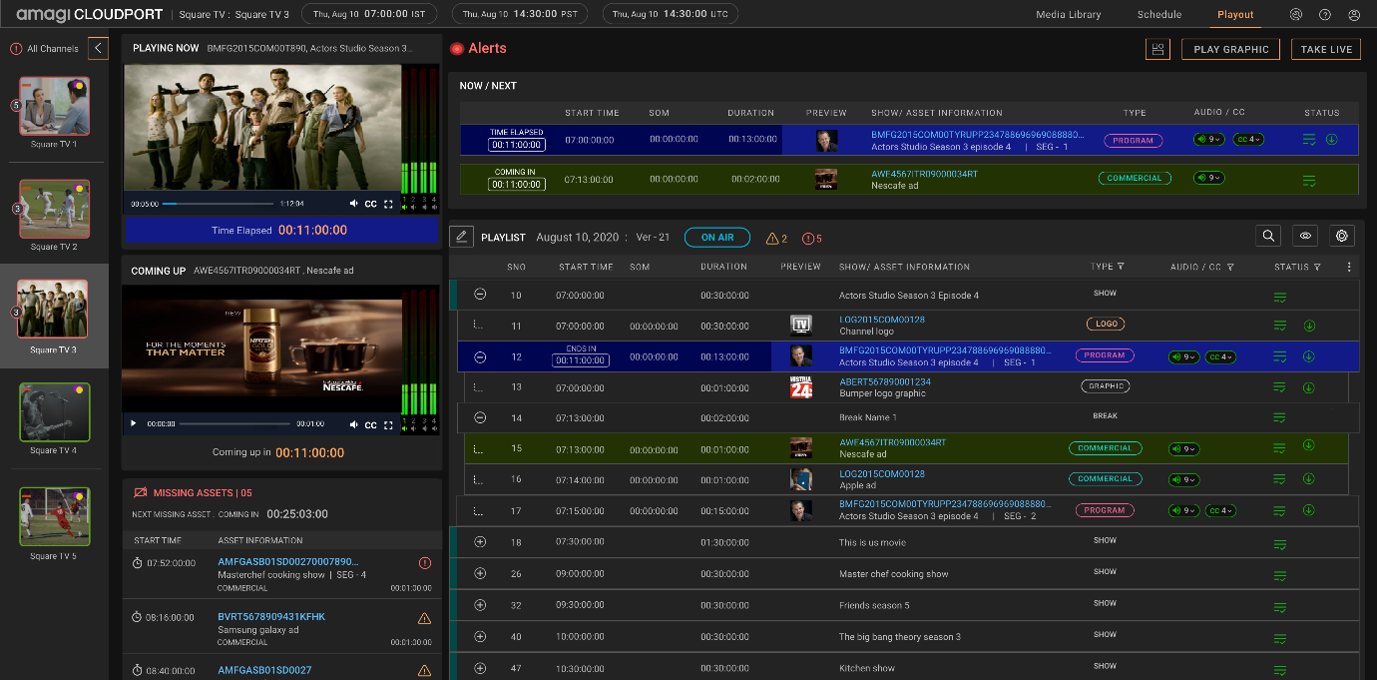Creating a Next-generation Cloud-based Newsroom
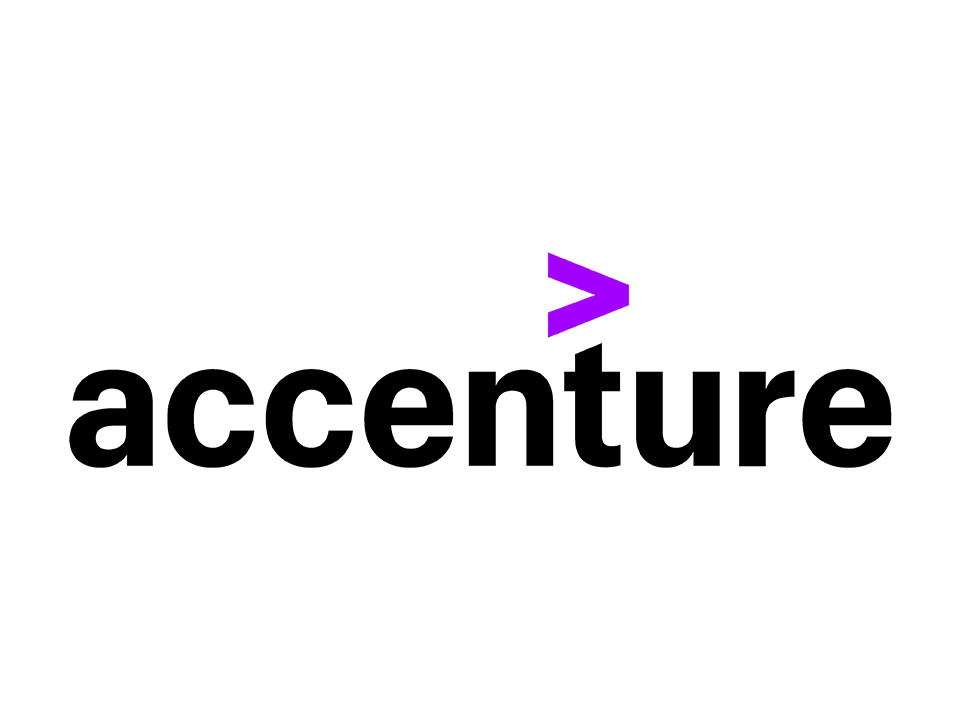

15 Local Market News Channels managed by 1 Team of 7 People
100x more content created with 15% of the workforce
43m video views in 1 month across 4 FAST Channel platforms
Summary
NBCUniversal Local, a subsidiary of Comcast, set out to create, manage and distribute local ad-supported news channels across multiple digital platforms in a low-touch model that could be centralized to allow a single team to manage multiple news markets. The key requirement was to ingest local news broadcasts and reformat them for distribution as FAST (Free Ad-Supported TV) channels on digital platforms with different ad and delivery requirements than the original broadcast. Working with NBCU Local, Accenture developed an agile solution inspired by the MovieLabs® 2030 Vision but tailored to the needs of fast-paced local news production and digital content distribution, allowing NBCU to repurpose local content and take advantage of the growing FAST market for digital news distribution.
By centralizing media in the cloud and enabling a cloud production and operations environment, NBCU now has a single destination where all local news channels contribute content, a single cloud-based operations center for collaborative media processing, and a single point of distribution for that media. All core media tasks and workflows involved in the process can be performed and managed from anywhere at any time, including programming changes for digital ad breaks and live break-ins on digital platforms.
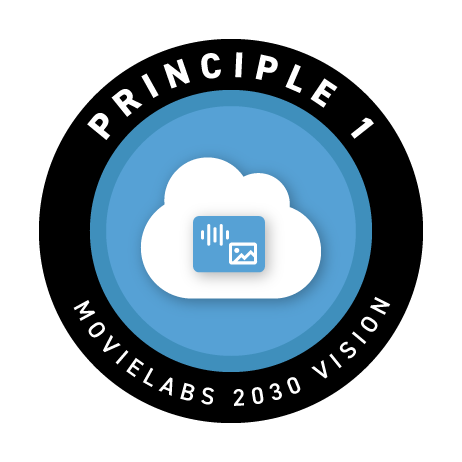
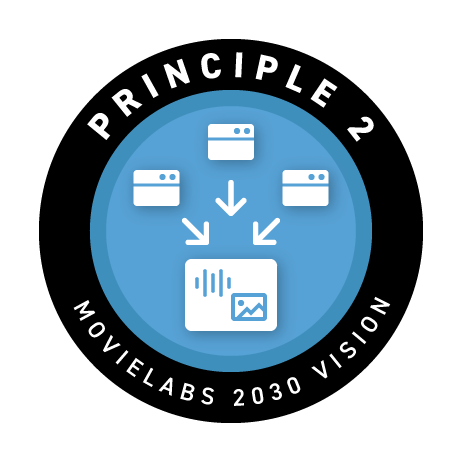
Background
Over the past 70 years, producing and distributing news has remained relatively unchanged compared to the advances made across the media industry. With the explosion of streaming and cord-cutting, NBCU Local was losing viewers; additionally, the entire media industry was looking for ways to remonetize content and extend its lifecycle. To remain relevant and forward-focused, NBCU partnered with Accenture to create and operationalize FAST Channels utilizing existing content to be distributed on FAST-supporting platforms such as Peacock, Roku TV and Samsung TV Plus. The goal was to do this with a small team that could contribute to and pull from any location through a virtualized workflow, with the ability to change ad breaks dynamically to conform to platform requirements and do live break-ins in any of the local markets to support the channels… all while being first to market.
Streaming to OTT platforms requires reformatting broadcasts to meet new platform requirements and delivery specifications – calling for skills, operating models and technologies the stations individually would not be able to stand up. This put the launch of the new channels at risk, which could have caused NBCU to miss out on a potential FAST service audience in the hundreds of millions. Accenture was asked to lead the build-out of new infrastructure for NBCU Local stations, all with their own varying capabilities and challenges, to enable the stations to contribute linear broadcasts and digital content to a cloud-based broadcast environment.
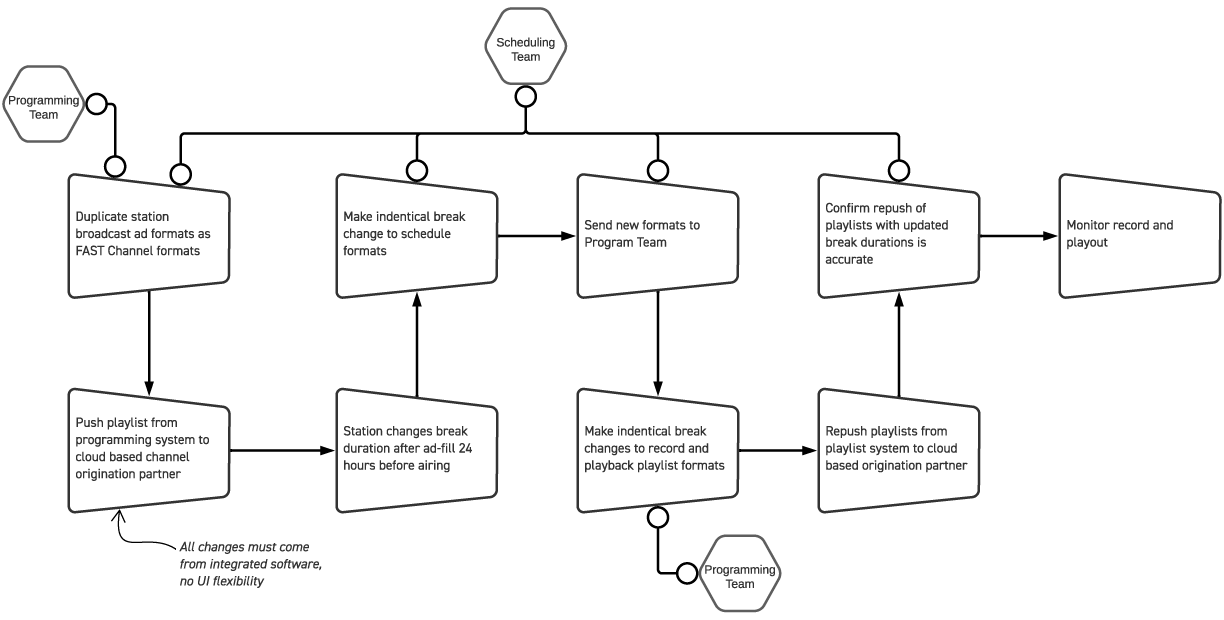
Figure 1: The diagram above illustrates the burdens that the old process imposed on scheduling and programming teams when trying to adjust digital streams to respond to last-minute changes in linear channel ad breaks
Solution
To address the problem, the Accenture team developed a cloud-based solution that incorporated the following goals:
- Establish a central media repository in the cloud that could be shared across all the local news channels and scaled to meet dynamic requirements.
- Enable local news channels to contribute local broadcasting content into the repository to be recorded as individual, editable segments.
- Make the central cloud repository a single source of truth for all production and distribution activities around the new FAST channels.
- Develop a largely automated cloud-based production and operations environment that could be managed by a distributed team, accessed by any of the participating local teams, and receive contribution from any number of live or recorded sources with full production editing capabilities such as live broadcast graphics.
- Give the cloud-based operations team the ability to serve ads, adjust ad breaks and do live break-ins dynamically to respond to changes in live broadcasts while conforming the stream to ad and delivery requirements of digital platforms.
- Deliver FAST channels from the cloud environment with a common interface to any digital platform able to accept the stream.
- Contribute digital content to a single repository with broadcast shows so that digital content can be scheduled between broadcast segment playbacks either as filler content or full digital shows.
- Compile an entire FAST channel via a pre-determined schedule as a singular digital linear stream for distribution that allows for last-minute dynamic changes and breaking news cut-ins, managed from a singular interface.
With the new solution now in place, applications including channel origination, channel distribution, live contribution and AI/ML services (e.g., automated closed captioning) can be assembled to fit the specific needs of the digital content strategy of each local news channel as well as NBC Local as a whole. The solution streamlines content distribution activities, enabling NBCU to compile a singular stream comprised of linear local news broadcasts and digital content to be distributed to any number of digital platforms capable of receiving and “rebroadcasting” a FAST stream, all from a common platform and interface. The dynamic interface allows the team to simplify complex workflows such as:
- Making on-the-spot changes that align with the local breaking news environment;
- Enabling a shortened ideation-to-launch window, i.e., station digital teams can pitch new show ideas on Monday and leverage existing capabilities to have the new format scheduled and playing out as quickly as Friday;
- Launching a new, revenue-generating channel in a matter of weeks.
The collaborative streamlined workflows enabled by the solution increases efficiency and will allow operation and scaling of channels with greater ease.
Architecture
The architecture of the environment is cloud first. All media broadcast is captured via Elemental cloud encoders and Amagi IP feed recording technology and sent directly to a single cloud endpoint for multiple local channels. All FAST distribution then originates from the cloud-based operations center. The solution follows a spoke and hub model, where the centralized cloud repository is fed program output from 25+ different on-site local newsrooms. The cloud encoder and recorder captures the video with embedded SCTE (Society for Cable Television Engineers) standard markers, which allow for insertion of ads and other content, as well as closed captions (CC). Essentially, upon ingest the local ad content is stripped out while the ad markers are retained so new digital insertions can be made later.
From the centralized channel repository, a small team then uses a cloud production and operations environment to process the local output and program the channel playlists with a mix of recorded and planned live media. The cloud production and operations environment consists of TVU Producer for virtual production and live break-ins, with an integration of Singular.Live for live graphics, Amagi Cloudport as the cloud origination and playout hub, AWS cloud video network infrastructure for transport, plus integrations with AWS transcribe for CC, NBCU’s proprietary scheduling and programming tools, and Gracenote for EPG distribution. The cloud operations center enables operators to change ad breaks to conform to multiple different platform requirements and program live break-ins for FAST channels based on new live content contributed by the local channels. The ad break changes are automated to respond to local ad triggers.
The solution then creates live video outputs and distributes the channels to multiple partner platforms from that centralized channel origination platform.
In the past year we have launched 15 brand new, first-of-their-kind FAST channels that air on multiple streaming platforms in 2 languages, representing teams across the country. And did I mention we’re doing this with a team of 7 people?”
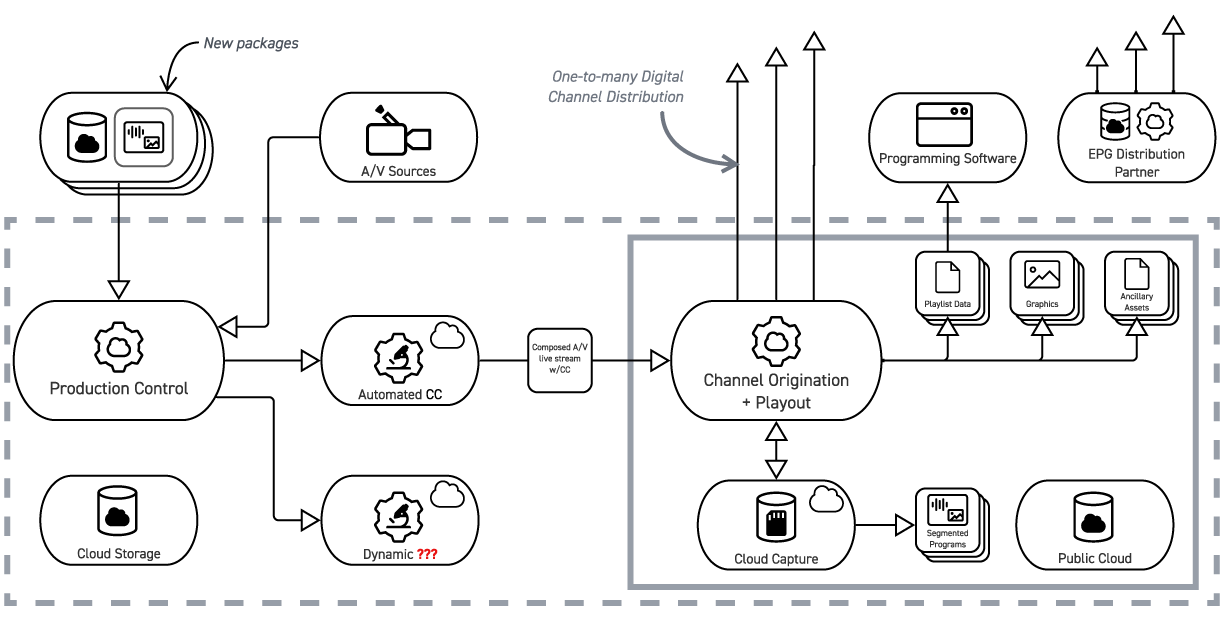
Figure 2: Above is a depiction of the new cloud-based process showing ingestion of new content which is then processed in the cloud and distributed from one cloud environment to multiple FAST channel distributors.
BENEFITS
With media centralized in the cloud, the system provides a single destination for contribution and a single collaboration site for processing of media, which then serves as a single point of distribution for that media. All tasks can be performed in one production control room in the cloud and the entire workflow can be managed from anywhere, at any time. The centralized repository and control structure minimizes storage costs and duplication of media, reduces errors, enables increased security, and eliminates duplicative tasks (e.g., eases distribution of content across multiple channels). It also mitigates the complexity of a non-centralized approach which would have required duplicate infrastructure and workflows at multiple locations.
The dynamic workflows with a single storage pool mean that there is no file movement to manage, giving NBCU the ability to bring cloud-based applications to the media and allowing anyone to contribute from anywhere. Cloud-based applications including channel origination, channel distribution, live contribution and AI/ML services are assembled to fit the specific needs of the content strategy and business. With channel origination software based in the cloud, NBC can take local products to any platform capable of receiving a stream, all from a common platform and interface. They can also activate new channels, with a pool of media to recombine and reconfigure into tailored experiences. NBCU also leverages a common metadata format across all FAST channels from established industry partner, Gracenote, to act as a standardized syndication partner for metadata distribution.
The original workflows established to populate schedules in NBCU’s cloud environment proved increasingly cumbersome as the product grew. In order to act on daily ad format changes, there had to be a lot of communication between several groups within a short timeframe. To improve workflow, NBCU reconfigured in-place and cloud-based metadata and interfaces to automatically record ad durations and update formats with minimal intervention. As a result, NBCU Local was able to automate much of the process around changes to ad breaks and formats, eliminating a great deal of manual work for the programming and scheduling teams., The new automated workflow also enabled NBCU to act upon audience engagement and other analytics feedback more quickly and easily. Near real-time response to that feedback has increased efficiency with the ability to operate and scale channels with greater ease.
Overall, the solution has enabled NBCU to:
- Deliver 15 local FAST channels into distribution using the new platform and cloud infrastructure.
- Centralize production and collaboration on virtualized infrastructure in a cloud-based environment.
- Streamline content distribution across all FAST channels.
- Operate and scale operations to fit dynamic requirements with greater ease.
- Maintain a single repository for contribution, collaboration and distribution.
- Take local news products to any FAST-capable platform, all from a common interface.
- Adapt channels to distribution platforms – e.g., Roku requires eight 2-minute fixed ad breaks per hour. The platform automatically creates conforming ad breaks based on platform requirements.
- Reduce time to market for new FAST channels. The creation of new channels takes 3-6 months depending on partner capabilities and specific media strategies. In a traditional broadcast model a new channel launch could cost millions and take years.
NBCU creates, produces, and manages these FAST Channels with a fraction of the operations and support teams required for traditional broadcast offerings. The original 15 FAST channels envisioned by NBCU and Accenture are programmed through an aggregation of content from 25 stations, pulled in 5 variations (live, live-to-tape, pre-taped segments, social media cuts, and standalone digital series and docs). In a typical news show, there are around 10 operators in play to make the show happen – firing ad breaks, firing graphics, loading clips, switching cameras, operating cameras, etc. In the new automated workflow model, NBCU essentially piggybacks off the station work to produce the FAST product, effectively doubling the output of those operators. The same can be said for programming and scheduling, playout engineers etc. The new FAST channels are fully supported by a team of 7. In traditional news a single station producing and distributing 1 form of content has a team of 50+. The FAST Channel team produces over 100x more content than a traditional news team with 15% of the resources.
We’ve become the hotspot for other stations to come visit and learn about how we can accomplish this output with so few people. Representatives from stations around the country are asking “How are you doing this?” and it’s causing them to look at their staffing, resources and say “hey, we can now make digital only shows with what we have.”
Alignment with MovieLabs 2030 Vision Principles
The NBCU solution successfully demonstrates the MovieLabs 2030 Vision principles in multiple ways:
PRINCIPLE 1
The first step towards realizing NBCU Local’s vision was to make the content available to any team member, anywhere by ensuring assets go straight to the cloud. By implementing technology that allows each station to stream directly to a dedicated cloud-capture device, all of the local station broadcasts go straight into the cloud and do not need to move for channel programming, origination, or playout. In addition to the broadcast, other assets such as programming data, graphics, slate, filler (“rescue”) content, and emergency playlists all go directly to that shared storage pool and are available to be used in any channel that is configured to receive that content.

PRINCIPLE 2
The core application of the solution is channel origination and playout. With all of the elements needed to compose the channel – playlist data and assets – on the cloud, the channel origination application has access to a continuous flow of data to support a 24/7 news channel. From here, NBCU can add additional media processing applications, such as a cloud-based production control as well as a cloud-based editing tool. The virtual operations control room runs in the cloud adjacent to the content, allowing the central team to manage ad breaks, live break-ins, automate closed captioning based on AI/ML services, and reformatting of content in a largely automated workflow.

Partners
Amagi provided the core software for unifying linear and OTT broadcast workflows, including for content creation and content distribution to FAST channels, as well as IP feed recording technology to capture streams for contribution into the cloud.
TVU Networks provided virtual production control room platform to manage sources and create live segments.
DNF Controls provided broadcast automation technology to convert contact closure signaling into IP-based signals.
Amazon Web Services (AWS) provided cloud storage and hosting for the media and applications.
Lessons Learned
One key learning was around the skills required to operate a centralized cloud-based solution, which proved to be less those of a broadcast engineer and more focused on operations, i.e., monitoring, alerting, triage. There also was a key learning around the interaction between cloud and on-prem environments, i.e., implementing a cloud-based system does not mean the end of on-prem production. Instead, it requires the on-prem production environment to be architected with automation in mind to ensure smooth interaction with the cloud-based production environment.
Industry partners would do well to invest heavily in engineering and digital product teams up front, enabling a more automated and streamlined operations team to rely less on engineering support on a day-to-day basis. Proper Continuous Integration (CI)/Continuous Deployment (CD) pipeline implementation is critical to surviving in the FAST world, as these channels need to be created and delivered at a blistering pace.
Next Steps
There are several expansions under consideration by NBCU Local:
- Improve accuracy and automation of recordings by tying the record logic more directly to the timing of the individual station broadcast control rooms rather than relying on scheduling data.
- Integrate NBCU Local’s digital Content Management System (CMS) to create more content contribution paths
- Attach a virtualized edit solution and a Product Asset Management (PAM)/Media Asset Management (MAM) system to create a more robust post-production ‘facility’ on-cloud.
MOVIELABS PERSPECTIVE
The NBCU Local implementation built with Accenture demonstrates that the MovieLabs 2030 Vision principles are as applicable to distribution of live, local TV channels as they are to content creation for major movies. The solution created here is a great example of how a single source of truth in the cloud can dramatically cut down storage costs and time delays from duplicating and moving media to chase applications. The media processing, composition and playout of the content are all applications operating on the media where it resides instead of needing to move the media to those apps. In this case the technology actually created the business opportunity as NBCU Local was not able to service the FAST market opportunities in an efficient manner without the new automation and cloud systems created here. With the integration of new cloud tools to enable editors to work on this content remotely from the cloud, we’ll see the convergence of distribution platforms seamlessly enabling new content creation workflows – a great example of breaking down the barriers between traditional content creation and distribution silos.
Get the Case Study
Download a free PDF of this case study

